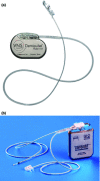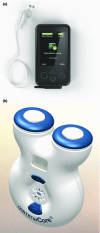Surgically implanted and non-invasive vagus nerve stimulation: a review of efficacy, safety and tolerability
- PMID: 25614179
- PMCID: PMC5024045
- DOI: 10.1111/ene.12629
Surgically implanted and non-invasive vagus nerve stimulation: a review of efficacy, safety and tolerability
Abstract
Vagus nerve stimulation (VNS) is effective in refractory epilepsy and depression and is being investigated in heart failure, headache, gastric motility disorders and asthma. The first VNS device required surgical implantation of electrodes and a stimulator. Adverse events (AEs) are generally associated with implantation or continuous on-off stimulation. Infection is the most serious implantation-associated AE. Bradycardia and asystole have also been described during implantation, as has vocal cord paresis, which can last up to 6 months and depends on surgical skill and experience. The most frequent stimulation-associated AEs include voice alteration, paresthesia, cough, headache, dyspnea, pharyngitis and pain, which may require a decrease in stimulation strength or intermittent or permanent device deactivation. Newer non-invasive VNS delivery systems do not require surgery and permit patient-administered stimulation on demand. These non-invasive VNS systems improve the safety and tolerability of VNS, making it more accessible and facilitating further investigations across a wider range of uses.
Keywords: depression; epilepsy; headache; implantable; migraine; safety; transcutaneous; vagus nerve stimulation.
© 2015 The Authors. European Journal of Neurology published by John Wiley & Sons Ltd on behalf of European Academy of Neurology.
Figures



References
-
- Beekwilder JP, Beems T. Overview of the clinical applications of vagus nerve stimulation. J Clin Neurophysiol 2010; 27: 130–138. - PubMed
-
- Ben‐Menachem E, Manon‐Espaillat R, Ristanovic R, et al Vagus nerve stimulation for treatment of partial seizures: 1. A controlled study of effect on seizures. First International Vagus Nerve Stimulation Study Group. Epilepsia 1994; 35: 616–626. - PubMed
-
- Ben‐Menachem E. Vagus nerve stimulation, side effects, and long‐term safety. J Clin Neurophysiol 2001; 18: 415–418. - PubMed
-
- Goadsby P, Lipton R, Cady R, Mauskop A, Grosberg B. Non‐invasive vagus nerve stimulation (nVNS) for acute treatment of migraine: an open‐label pilot study [abstract S40.004]. Presented at Annual Meeting of the American Academy of Neurology, 16−23 March 2013, San Diego, CA.
-
- Jurgens TP, Leone M. Pearls and pitfalls: neurostimulation in headache. Cephalalgia 2013; 33: 512–525. - PubMed
Publication types
MeSH terms
LinkOut - more resources
Full Text Sources
Other Literature Sources
Medical

